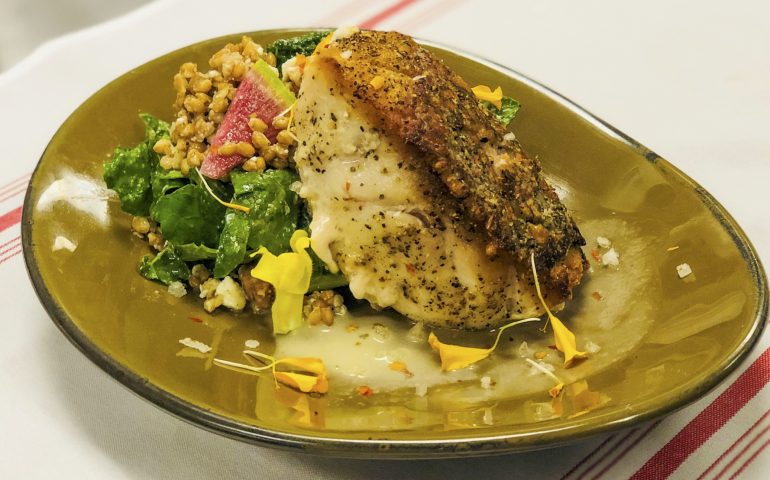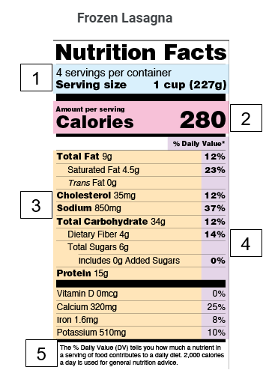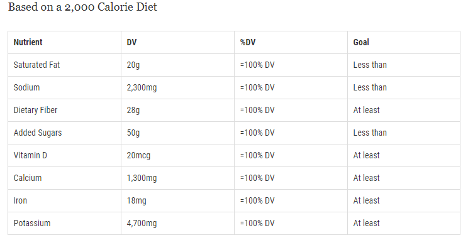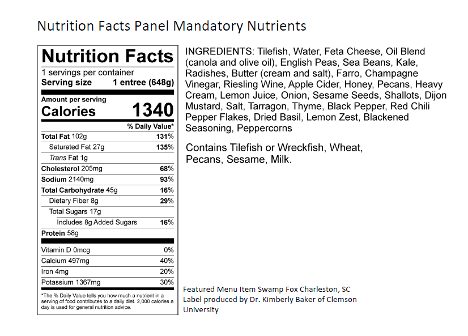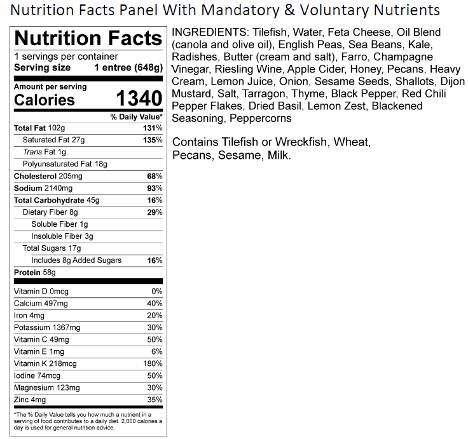Continued two-part series on food choice & nutrition labels, their history, how to read them, & why you should care
Written by Eminah Quintyne. View part one of this series here.
What we eat breaks down to its simplest form and that reveals how it will affect you. Nutrition labels provide detail on how foods break down into smaller parts.
As stated in part one of “Look Before You Eat” – every ingredient in a recipe on a nutrition label has been analyzed in a lab for its nutrient content. The combined impact from the sum of all a recipe’s ingredients is what is reported to you on an FDA-approved nutrition label, and local foods particularly fruits and vegetables will give the greatest amount of nutrients.
The chemical composition of foods and their biochemical impact on the human body will influence your health and affect your quality of life, hence why you should care about and learn about what you eat.
Researchers state in a study of more than 500 undergraduate and graduate students, approximately 90% of students could not define serving size, and one-third could not perform simple tasks involving comparison of nutrition labels. Other studies conclude people do not know how to calculate total calories in a package or identify grams of carbohydrates in more than one serving. When it comes to Nutrition labels everything starts with serving size.
How to Read a Nutrition Label:
1 — Serving Size – is a helping of food. It literally is a (number) that represents a quantity of food. A serving of food on a nutrition label is directly linked to all the nutrition facts (calories + nutrient data). Nutrition facts are shown in light yellow on number three (3) of the graphic. Those facts are only true per helping or serving of food. What you get out of a food is based on how much of the food you eat. On a nutrition label, you have to measure value relative to the amount of food consumed. You can learn what a food value is from the calorie and nutrient facts section of a label. A serving is NOT a recommendation from the federal government on how much food you should eat at one time. Based on survey data serving size relates to the amount of food customarily consumed. Here’s what to ask yourself:
What is the serving size of frozen lasagna? 1 cup or 227 grams
How many servings are there per container of frozen lasagna? 4
If you eat two servings of lasagna how many calories did you consume? 560
280 Calories x (2 servings) = 560 Calories
If you eat two servings of lasagna how much fiber and total carbohydrate did you consume?
4g (Dietary Fiber) x (2 servings) = 8g of Dietary Fiber consumed
34g (Total Carbohydrate) x (2 servings) = 68g of Total Carbohydrates consumed
Here is the kicker — because your body does not absorb fiber into your bloodstream (digest) it does NOT affect blood sugar levels. Carbohydrates are composed of three (3) components: starch (complex carbohydrates), fiber, and sugar. Fiber is also identified as a complex carbohydrate and is great for digestive health. You can think of complex carbohydrates like a pearl necklace. It is a chain of individual glucose molecules strung together. All carbohydrates except fiber break down into sugar (individual glucose molecules or individual pearls). Therefore, any time you see an amount indicated for fiber, subtract it from total carbohydrates to get net carbs.
What is the amount of net carbohydrate consumed in two (2) servings of frozen lasagna (solve for net carbohydrates)?
4g (Dietary Fiber) x (2 servings) = 8g of Dietary Fiber consumed
34g (Total Carbohydrate) x (2 servings) = 68g of Total Carbohydrates consumed
68g of Dietary Fiber consumed (minus) 8g of Total Carbohydrates consumed = 60g of net carbohydrate consumed
This is easy! Just remember the number of calories and nutrients like fiber, saturated fat, or vitamin D, etc. consumed is indicated PER SERVING.
2 — Calories – A calorie (lower case c) is a unit used to measure heat energy. Inches, meters, yards, etc. are units used to measure length. Liters, gallons, and pints, are units used to measure volume. Get it?! Good!! A calorie (lower case c) is the scientific name of the unit used to measure heat energy found in food (food energy).
The method used to determine the amount of food energy is done via a (bomb calorimeter). All food is divided into three groups called macronutrients i.e. protein, fats, and carbohydrates. To discover the amount of heat energy in each macronutrient, each macronutrient was individually placed in a separate sealed container surrounded by water (bomb calorimeter). 1 gram (g) of each macronutrient was heated with fire until it completely burned. The temperature of the surrounding water was taken after each macronutrient was completely burned. That temperature represents the amount of heat energy required or produced by 1 gram (g) of each burned macronutrient. The number of calories in each macronutrient is based on the bomb calorimeter method.
- 1-gram carbohydrate = 4 kilocalorie (kcal)
- 1-gram protein = 4 kilocalorie (kcal)
- 1-gram fat = 9 kilocalorie (kcal)
Food labels communicate food in terms of kilocalories using the unit Calorie (upper case C).
- 1 calorie (lower case c)
Measures the amount of heat required to raise the temperature of 1 gram of water by 1 °C. It takes 1 calorie (lower case c) to raise the temperature of 1 gram of water by 1 °C.
- 1 Kilocalorie (same thing as Calorie)
Measures the amount of heat required to raise the temperature of 1 kilogram (kg) or 1000g of water by 1 °C. Note: 1kg = 1000g. One kilocalorie raises the temperature of 1000 grams (g) of water by 1°C
- Calorie (same thing as a Kilocalorie)
Measures food energy in kilocalories (kcal). In other words, Calorie is the same thing as a kilocalorie and is what gets reported on FDA approved nutrition labels. Understand that a calorie (lower case c) itself is a small scope of measure. It is like the same number represented in milligrams(mg) vs. ounces (oz.). Milligrams are much smaller than ounces.
- One serving of frozen lasagna = 280 Calories; actually means 280 kilocalories that is: 280 kcals x 1000 = 280,000 calories (lower case c)
- Conversion factor: 1 kilocalorie (kcal) = 1000 calories (lowercase c)
Because you will end up with long numbers of several digits, the calorie (lower case c) is not a practical way to document the actual amount of energy in food.
- 1 kilocalorie = 1000 calories (lowercase c)
- 1 Calorie = 1 kilocalorie (Equivalent)
- calorie (lowercase c) = the most common unit of heat.
This can be confusing. The information is provided for deeper understanding. Most people will not get into this level of detail, but it’s not too complicated and it is interesting! Accept the number of Calories on a nutrition label as provided. Understand the body functions from a larger number of kilocalories.
3 — Nutrients
List of 14 nutrients legally required on a U.S Nutrition label (list reflects the 2016 amendments to the Food, Drug, and Cosmetic Act):
- Total Fat = Macronutrient → 1g Fat = 9 kilocalories
- Saturated Fat
- Trans Fat
- Cholesterol
- Sodium
- Total Carbohydrate (Carbs) = Macronutrient → 1g Carbs = 4 kilocalories
- Fiber → Because fiber is non-digestible subtract fiber from total carbohydrates
- Total Sugars
- Added Sugars → Do not occur naturally within whole ingredients like potatoes. This includes syrup, brown sugar, honey, dextrose, etc. added to a recipe
- Protein = Macronutrient → 1g Protein = 4 kilocalories
- Vitamin D
- Potassium
- Calcium
- Iron
4 — %DV – Percent Daily Value.
It represents how much of a nutrient like potassium contributes to one serving of food in the context of what is determined as the average daily level of intake sufficient to meet the nutrient requirements of nearly all (97%-98%) of healthy people1. %DV tells you how much one serving of food contributes to your daily nutrient needs. 100% DV is the total amount of a nutrient you need to get into your body every day. Daily nutrient requirements are produced by the Food and Drug Administration (FDA). See an abbreviated chart of requirements for daily nutrient needs below:
How many milligrams (mg) of iron are in the frozen lasagna? 1.6 mg
What is the % DV of iron per one serving? 8%
It is not likely that anyone is going to carry the %DV chart around so if you are looking at a Nutrition label on the go and want to know how much (100%) of iron or anything is Solve for 100% of DV:
Iron (See Frozen Lasagna) = 1.6mg
1.6 mg/(divided) by 8% that is 1.6/.08 which = 20 mg
100% of %DV is 20 mg
Potassium (See Frozen Lasagna) = 150mg
150mg/(divided) by 10% that is 150/.10 which = 1550mg
100% of %DV is 1550 mg
According to the FDA, a 5% DV or less of a nutrient per serving is considered low and 20% DV or more of a nutrient per serving is considered high2.
5 — Daily Diet – On every nutrition label at the very bottom in tiny writing there is a statement. All that message is telling you is the %DV we just solved for represents the number of nutrients recommended for a person on a 2000 kcal* diet. In other words, if everyone were to consume 2000 Calories a day that FDA chart is saying those figures are 100% of the number of nutrients you should consume daily.
Researchers state understanding the NFP label requires health literacy, that is, “the capacity to obtain, process, and understand basic health information and services needed to make appropriate health decisions”3. However, a sizable proportion of the US population is deficient in health literacy. Researchers also say inadequate health literacy has been associated with adverse health outcomes4.
I covered how to interpret the data on a nutrition label. The other side of that is understanding how to use the information and apply it in a meaningful way. You may be interested in watching videos or reading books on basic nutrition principles. I will touch on a few of these in this article.
Swamp Fox Restaurant is located in the heart of Charleston, SC in the Francis Marion Hotel. The restaurant overlooks Marion Square Park, features classic southern cuisine, and its chefs make it a point to incorporate local ingredients.
“As a chef, I am truly blessed here in the Lowcountry with the variety of ingredients available year-round. The relationships we have built with local farmers, fishermen, and producers over the years would probably be one of the main reasons we strive to source local ingredients. Once you visit some of their operations and see their efforts firsthand, it’s hard to want to purchase from anyone else. What they do is truly amazing and deserves credit. There is a story, a face, and a family behind every ingredient and it’s the least I can do to show my support. Not to mention the quality. Some of our ingredients here in South Carolina are second to none. I have worked as a Chef all over the United States and I say that with confidence, not bias because I am from SC. When the ingredient is fresh and in season, and not passed through dozens of hands, warehouses, processing facilities, etc. I truly believe it not only tastes better, but It also has to be better for you,” said Executive Chef Heyward Davis. Chef Davis is the Executive Chef at Swamp Fox. He attended Le Cordon Bleu College of Culinary Arts, has years of diverse culinary experience, and appreciates his southern roots.
Dr. Kimberly Baker, Registered Dietitian, Food Technologist, and Food Systems and Safety Program Team Director at Clemson University used Genesis nutrition labeling software to create an FDA-approved nutrition label for a seasonal menu item created by Chef Davis. I shadowed Dr. Baker while developing this unique offering. It is important to point out restaurants are mandated by different rules when providing information about nutrient content to the public. They are not required to provide a nutrition label for menu items, instead, restaurants are required to provide calorie count and a nutrition panel. (Click here to read part one of this series for more information on restaurant menu labeling).
We used this opportunity to promote local fare in a non-traditional fashion taking each ingredient from every component of a seasonal recipe to create a nutrition label. It’s not often that you will find such a provision for a restaurant entree. In this article, the Swamp Fox label is used as a tool to demonstrate how to apply data found on an FDA-approved nutrition label.
Seared Wreckfish with farro, lacinato kale, radish, split creek feta, smoked ladies island pecans, & cider beurre blanc. Mmm sounds good! Let’s, “Look Before We Eat”! On the menu, this dish is referred to as Seared Golden Tilefish or Wreckfish. Dr. Baker and I decided on providing two labels. One with mandatory nutrients and another with voluntary nutrients. I will focus on these one at a time. Take a look at the side by side of each label.
The 2015 Dietary Guidelines Advisory Committee report determined “nutrients of public health concern” in the US and concluded the population under consumes calcium, fiber, iron, potassium, and vitamin D while over-consuming saturated fat and sodium5. This finding led to the current list of mandatory nutrients on an FDA-approved nutrition label.
Take a closer look at the nutrition label for mandatory nutrition facts for Seared Golden Tilefish or Wreckfish:
Do not be alarmed by the number of calories. 3500 Calories is the equivalent of one pound of fat. Does that mean you should count calories on everything? No, not in my book. Calories do not tell you the full story of weight gain. The macronutrient (protein, carbs, fat) source of the Calories does. Glucose is the main source of energy for cells.
- Carbohydrates and most other forms of sugar are the only macronutrients that may cause the body to create fat without having to consume 3500 calories.
- You can consume less than 3500 calories from carbohydrates or simple sugars and gain fat if you consume more of this energy than what your body needs at one time.
- When the body does not need to use glucose for energy, excess glucose is stored in the liver and muscles as short-term reserved energy called glycogen.
It is very important to understand that getting too much sugar in your blood at one time may cause you to reach your glycogen (reserved energy) storage capacity. Excess reserved energy (glycogen) turns into fat (triglycerides) because your body has gone beyond the capacity or amount it can store glycogen.
“You want to know what you are putting in your body. Nutrition labels help people who are overweight, who have diabetes, heart failure, or other medical conditions. They’re beneficial. Calorie counts help people to know how much food to put in their body, what exercises to do to burn certain amounts of energy, and are functional in monitoring overall consumption,” said Dr. Uzuma Anaba. Dr. Anaba is an Internal Medicine physician. He attended medical school at the University of Toledo in Ohio and currently practices in the Well-Star Hospital system.
Let’s take a third look at The Seared Golden Tilefish or Wreckfish from Swamp Fox with voluntary nutrients:
Dr. Baker and I had fun with this. We added voluntary nutrient values for Vitamin C, E, K, Iodine, magnesium, and zinc. Food product developers have a legal option to provide voluntary nutrients in addition to the mandatory list of nutrients required on a nutrition label. Earlier I shared 5% DV or less of a nutrient per serving is considered low and 20% DV or more of a nutrient per serving is considered high2.
We are demonstrating value. Except for Vitamin E, every vitamin and mineral from this dish will provide a significant amount of micronutrients to your body. The 27 grams of saturated fat are primarily derived from the beurre blanc sauce; you can always get this on the side to monitor or prevent a high intake of saturated fat. There are 18 g of polyunsaturated fat that we added to the label to show you the good fats found in this dish. Polyunsaturated fats may help lower LDL (bad) cholesterol levels and include essential fatty acids omega-3 and omega-6 fats. They are essential because you have to get them from your diet. The body uses omega-3 and omega-6 fats to help with brain function and cellular growth.
Health Benefits of Seared Golden Tilefish or Wreckfish:
- High source of Iodine. Our bodies need iodine to produce thyroid hormones needed to regulate metabolism6. Deficiencies may cause complications. Your thyroid gland controls your metabolism6. Metabolism is the rate at which your body uses energy (Calories) from food. It is best to visit an Endocrinologist to find out if your thyroid gland works properly. If it doesn’t, that could mean it is more difficult for you to lose weight despite a good diet and exercise.
- High source of Vitamin K. Vitamin K helps to make the proteins that allow our blood to clot7. In the case of excessive bleeding from injury. It’s protective. Vitamin K also helps to build our bones and is classified as a fat-soluble vitamin7. That means it must be dissolved in fat to become bioavailable.
- High source of Zinc. Among other benefits, zinc aids in strengthening your immune system and helps your metabolism to function8. You want your body to effectively use the energy from food. That is very important. Zinc is a mineral that must be obtained through diet and is actually required in the body for gene expression, and protein and DNA synthesis8.
Many consumers check food labels when buying food, either to choose healthy foods or to lose weight4. Sustainable weight loss is an ongoing challenge for many people. Being overweight impacts physical health and self-concept.
To achieve weight loss, you have to get your body to a place to use (mobilize) stored fat. That means you are in a caloric deficit. That place is formally called Beta-oxidation. Just like there are a lot of ways to get to Paris – boat, plane, walk (people have tried it) there are a lot of recommended lifestyle changes and diets out there to achieve weight loss. Some options are going to be more efficient than others.
Ketosis occurs during Beta-oxidation. Ketosis occurs when your body produces ketones because there is not enough insulin in your blood. Insulin is a hormone that tells your body to take glucose into your cells. Hormones tell your body what to do. The presence of insulin in your blood generally means you have consumed food that broke down to glucose. If your body can use glucose for energy, it will not use stored fat (the fat many want to go away). Keto is a buzzword word stemming from ketosis. It means your body does not have enough glucose in your blood so it starts breaking fat down and using it for energy, hence weight loss.
What you eat impacts the expression of life. We know art as the imitation of life. People document things, adventures, and emotions in life. May it be a painting, music, words, a melody. What we eat is highly associated with quality of life. Food nutrition labels are designed to help you make informed food choices and control the narrative of your life. I encourage you to do what you can to thoughtfully enjoy food, learn about your body, and be the best version of yourself. I love food and want the world to enjoy food without a headache, excess weight gain, or negative health effects. If you’re ever in the Charleston area visit Swamp Fox! It’s located at 387 King St, Charleston, SC 29403. Your experience will definitely be a treat.
—
Written and provided by Eminah Quintyne, a volunteer contributor to the 2021 Eat Local Challenge. Eminah is a food science professional with an MPH in health policy and management and BS in nutrition and food sciences. Eminah is on her way to becoming a Registered Dietician Nutritionist in 2021 and is assisting Lowcountry Local First with the Eat Local Challenge as part of her learning experience. Look for informative pieces from her throughout the challenge, spotlighting why local foods are often more nutritious.
—
References
- Galsgaard KD, Pedersen J, Knop FK, Holst JJ, Wewer Albrechtsen NJ. Glucagon Receptor Signaling and Lipid Metabolism. Front Physiol. 2019;10:413. Published 2019 Apr 24. doi:10.3389/fphys.2019.00413
- https://www.fda.gov/food/new-nutrition-facts-label/how-understanhttps://www.fda.gov/food/new-nutrition-facts-label/how-understand-and-use-nutrition-facts-labeld-and-use-nutrition-facts-label> [Accessed 6 June 2021].
- Selden CR, Zorn M, Ratzen S, Parker RM. Health Literacy. Current Bibliographies in Medicine 2000-1 2000. whttps://www.nlm.nih.gov/archive//20061214/pubs/cbm/hliteracy.html. [Accessed 6 June 2021].
- Persoskie A, Hennessy E, Nelson WL. US Consumers’ Understanding of Nutrition Labels in 2013: The Importance of Health Literacy. Prev Chronic Dis. 2017;14:E86. Published 2017 Sep 28. doi:10.5888/pcd14.170066
- Dumoitier A, Abbo V, Neuhofer ZT, McFadden BR. A review of nutrition labeling and food choice in the United States. Obes Sci Pract. 2019;5(6):581-591. Published 2019 Nov 14. doi:10.1002/osp4.374
- MYANT NB, POCHIN EE. The thyroid clearance rate of plasma iodine as a measure of thyroid activity. Proc R Soc Med. 1949;42(12):959-961.
- Simes DC, Viegas CSB, Araújo N, Marreiros C. Vitamin K as a Diet Supplement with Impact in Human Health: Current Evidence in Age-Related Diseases. Nutrients. 2020;12(1):138. Published 2020 Jan 3. doi:10.3390/nu12010138
- Olechnowicz J, Tinkov A, Skalny A, Suliburska J. Zinc status is associated with inflammation, oxidative stress, lipid, and glucose metabolism. J Physiol Sci. 2018;68(1):19-31. doi:10.1007/s12576-017-0571-7

